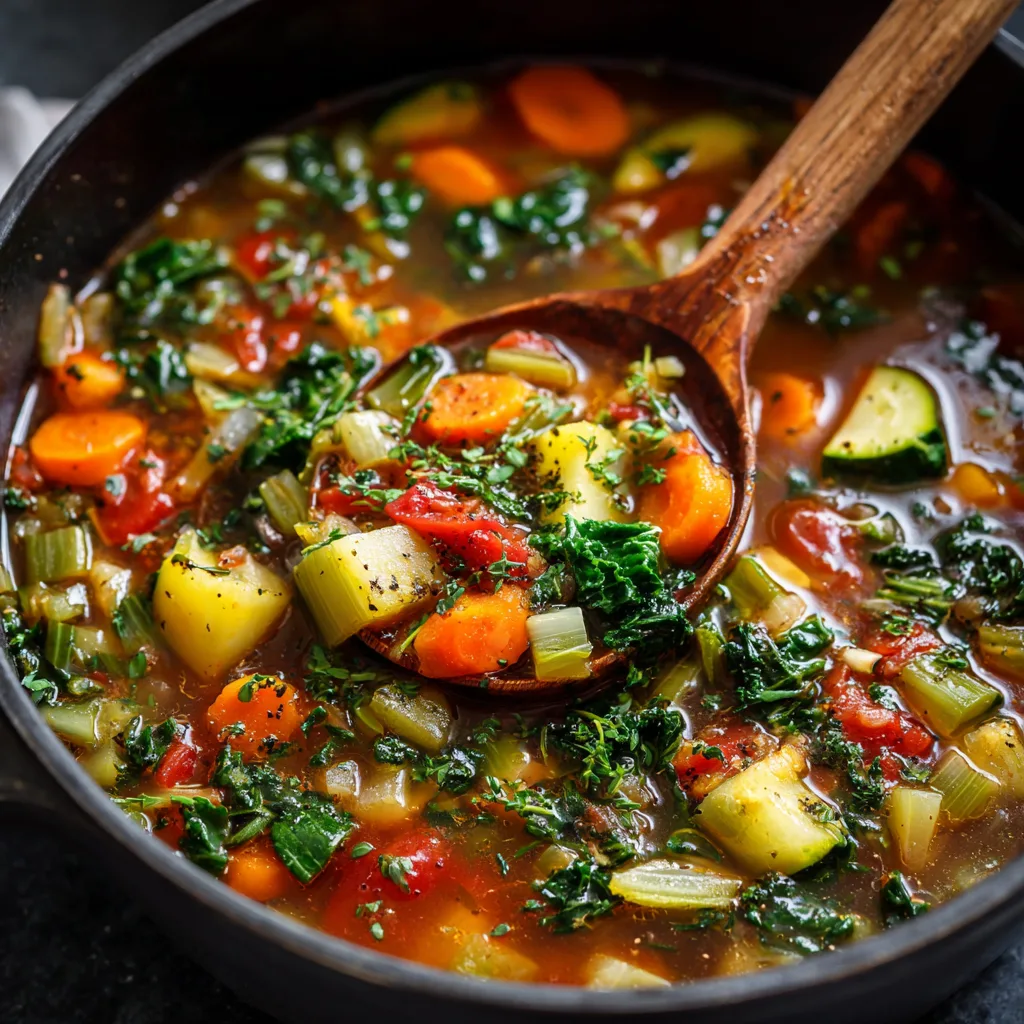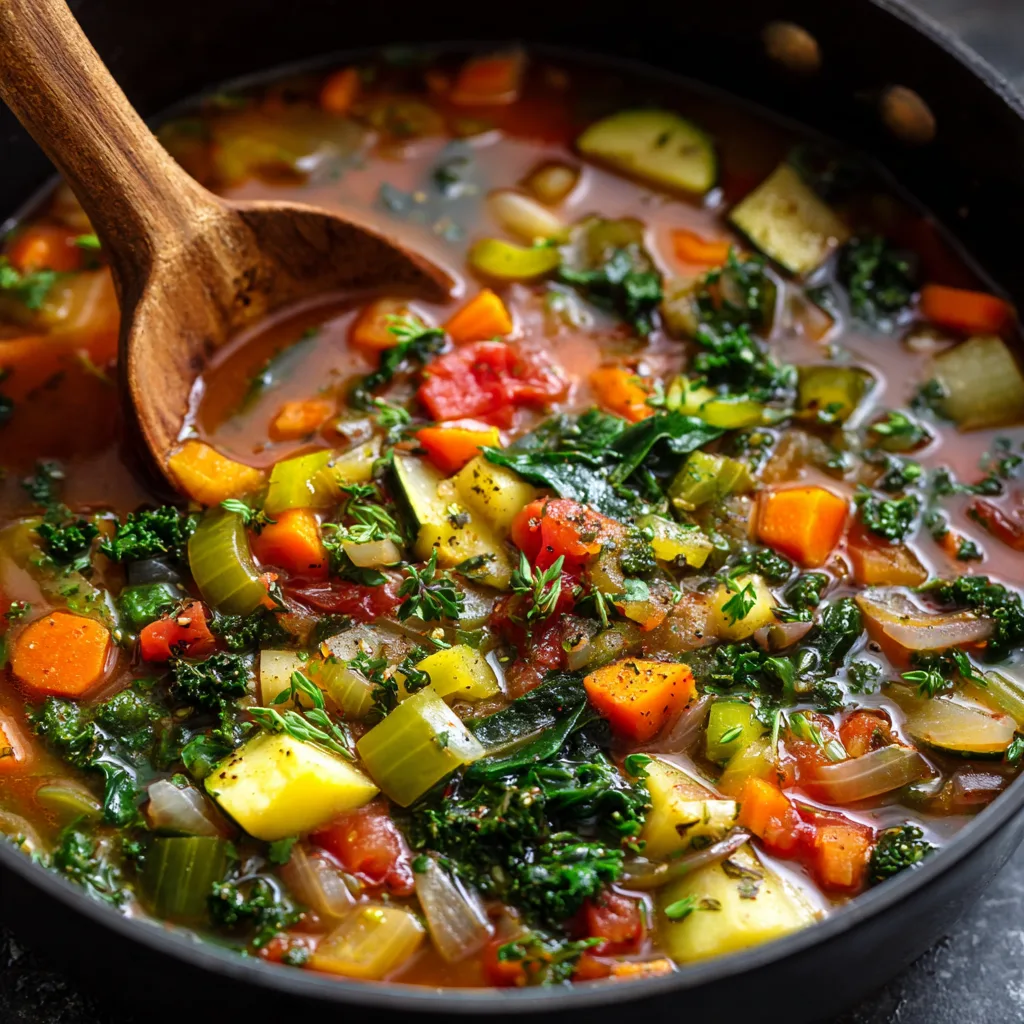What Is One‑Pot Vegetable Feel‑Better Soup?
One‑Pot Vegetable Feel‑Better Soup is a comforting, nutrient-rich dish made in a single pot. It brings together fresh vegetables, herbs, and healing spices to create a warm, soothing meal. This wholesome soup is perfect for busy days, sick days, or anytime your body craves nourishment without fuss.
Why “Feel‑Better”? Health, Comfort & Convenience
This soup earns its “feel‑better” title thanks to its powerful ingredients. It’s loaded with vitamin-rich vegetables like carrots, celery, potatoes, and leafy greens. Garlic and ginger not only add bold flavor but also boost the immune system and fight inflammation.
When you’re under the weather or simply worn out, this soup steps up. It’s easy to prepare, making it ideal for those with low energy. Plus, there’s no juggling multiple pans or fancy techniques—just chop, simmer, and serve. Cleanup is minimal, which is one more reason this recipe comforts the body and mind.
One‑Pot Cooking – Advantages & Appeal
One‑pot meals are beloved for good reason. They save time in both cooking and cleanup. With everything simmered together, flavors meld beautifully, creating deep, rich taste without extra steps.
Nutrient retention is another big win. Because vegetables cook directly in the broth, they release and retain their vitamins, infusing the soup with healing power. Unlike boiling or roasting separately, one‑pot cooking keeps nutrition locked in.
This method also taps into a growing trend. From modern kitchens to traditional recipes, one-pot cooking has gained popularity worldwide. It’s efficient, satisfying, and fits into any lifestyle. Whether you’re new to cooking or a seasoned home chef, one‑pot soups are the kind of recipe you’ll return to again and again.
Building the Flavor Base – Mirepoix & Aromatics
Every great soup begins with a strong foundation, and for this one, it starts with a mirepoix. This French cooking staple combines diced onion, carrot, and celery to build layers of flavor and aroma. When cooked gently in a bit of oil, the vegetables soften and sweeten, forming a rich, savory base.
To enhance that foundation, this soup brings in powerful aromatics. Garlic adds depth and warmth, while fresh ginger introduces a gentle heat that awakens the senses. Turmeric, a golden root known for its anti-inflammatory properties, gives the broth a subtle earthiness and vibrant color.
Fresh or dried herbs elevate the mixture even further. Thyme, bay leaves, and parsley work beautifully, while rosemary or oregano can add bold herbal notes. This combination of mirepoix and healing aromatics transforms a humble pot of vegetables into a bowl of nourishing comfort.
The beauty lies in the balance—each ingredient plays a role, but none overpowers. Together, they create a naturally flavorful, comforting base that invites endless customizations while keeping preparation simple.
Vegetable Choices & Seasonal Swaps
The vegetables you choose define the body and texture of the soup. At its heart, this recipe relies on classic, accessible staples like potatoes, cabbage, peas, and corn. These ingredients hold up well during simmering, absorb flavor efficiently, and deliver key nutrients like fiber, potassium, and vitamin C.
Beans offer plant-based protein and creaminess, whether you choose white beans, chickpeas, or lentils. Their mild flavor blends well with the broth, making the soup feel more satisfying and complete.
For seasonal flair, swap in what’s fresh and local. Butternut squash and kale bring heartiness in fall and winter, while zucchini and green beans shine in spring and summer. These changes not only keep the soup exciting but also support variety in your diet.
The goal is flexibility. Use what’s on hand or what’s in season, and the soup adapts with ease.
Liquid & Creaminess Options
The choice of liquid shapes the soul of the soup. A good vegetable broth offers depth and savory notes, while bone broth adds richness and nutrients for those who enjoy it. Even plain water can work when paired with enough aromatics and seasoning.
If you crave a creamy version, stir in coconut milk, dairy cream, or a plant-based alternative. Each brings a smooth, silky texture and a subtle sweetness that rounds out the flavor. The result is a comforting soup that feels indulgent while staying wholesome.
Prep: Chopping & Mise‑en‑Place
Before the heat hits the pot, preparation is key. Start by washing and peeling your vegetables. Dice the onion, carrot, and celery evenly to ensure they cook at the same rate. Uniform cuts also improve texture and presentation.
Next, organize your ingredients. Lay out the aromatics, liquids, beans, greens, and seasonings. Knowing the cooking order helps prevent overcooking and ensures layers of flavor develop naturally. When everything is chopped and measured ahead of time, the cooking process flows smoothly and stress-free.
Sautéing the Aromatics
Begin with a warm pot and a splash of oil. Use olive oil for a rich base or avocado oil for a neutral flavor and higher smoke point. Add the mirepoix—onions, carrots, and celery—and cook gently.
Here, you have two techniques. Sweating the vegetables over medium heat brings out natural sweetness without browning. This creates a clean, mellow base. On the other hand, letting the onions and carrots brown slightly adds depth and a touch of caramelized richness.
Once softened, stir in garlic, ginger, and turmeric. These aromatics release their oils quickly, so give them just one to two minutes of heat. Keep stirring to prevent burning. This short but crucial step unlocks bold flavor and prepares the pot for your vegetables and broth.
Building the Soup – Adding Veg & Liquid
After the aromatics are cooked, it’s time to build your soup. Add hearty root vegetables first—potatoes, sweet potatoes, carrots—since they need more time to soften. Stir to coat them in the flavored oil and spices.
Next, pour in the broth. Use just enough to cover the vegetables. Bring it all to a boil, then reduce to a gentle simmer. Timing matters. Allow root vegetables to cook for 10 to 15 minutes until they’re nearly tender.
Add softer vegetables like zucchini or green beans toward the end. They only need a few minutes and can turn mushy if added too soon. Taste the broth as it simmers—this helps you adjust seasoning early on.
Incorporating Texture – Beans, Greens & Cream
With the broth rich and the vegetables almost tender, it’s time to add texture and nutrition. Beans—like cannellini, chickpeas, or lentils—go in now. They warm through quickly and add body without breaking apart.
Next, stir in leafy greens such as spinach, kale, or chard. These only need a few minutes to wilt and blend into the soup. Add them near the end to retain color, nutrients, and bite.
If you’re making a creamy version, now’s the time. Pour in coconut milk, dairy cream, or your favorite plant-based substitute. Stir gently and heat through, avoiding a hard boil to maintain smoothness. This last step brings balance and comfort, making each spoonful velvety and rich.
Finishing Touches & Flavor Balance
Just before serving, brighten the soup with a splash of lemon juice or vinegar. This simple step sharpens flavors and balances the richness. Finish with a handful of fresh herbs like parsley, dill, or basil. Taste and adjust the seasoning with salt and pepper.
These final touches lift the soup from good to unforgettable.
Nutritional Benefits & Healing Properties
One‑Pot Vegetable Feel‑Better Soup is more than a cozy meal—it’s packed with health benefits. Every bowl delivers a wide range of vitamins, minerals, and antioxidants that support your immune system and aid recovery.
Carrots and sweet potatoes provide vitamin A, which promotes healthy vision and skin. Leafy greens like kale and spinach boost vitamin C and iron, helping fight fatigue and inflammation. Cruciferous vegetables such as cabbage and broccoli add fiber and natural detoxifying compounds.
The healing power doesn’t stop with the vegetables. Aromatics like garlic, ginger, and turmeric have anti‑inflammatory and antibacterial properties. These ingredients can help soothe colds, ease digestion, and reduce inflammation throughout the body.
With each spoonful, your body receives nutrients that restore energy and encourage healing. It’s a powerful, plant-based remedy for feeling run‑down, making this soup a smart choice whether you’re sick or simply need a wellness boost.
Dietary Needs: Vegetarian, Vegan, Gluten‑Free
This soup fits easily into a variety of diets. At its core, it’s vegetarian and often vegan by default. Just be mindful of the broth. Some vegetable stocks may contain additives, so check labels or make your own for full control.
For a vegan version, skip any dairy ingredients. Instead, use coconut milk, oat cream, or cashew cream for richness. Nutritional yeast can also add a cheesy flavor without any animal products.
Need to go gluten‑free? This soup naturally contains no wheat. Still, if you plan to thicken it or serve with bread, use certified gluten‑free flour or starch. Always double‑check broth and canned beans for hidden gluten-containing ingredients.
This flexible base allows you to adapt the recipe easily while staying true to your dietary goals. Whether you’re feeding a vegan family member or avoiding gluten, this soup has you covered.
Protein Boosts & Grain Add‑Ins
To make the soup more filling, you can add extra protein and complex carbs. Beans and lentils are go-to options that work beautifully. They bring fiber and plant protein while blending into the broth’s texture.
Chickpeas hold their shape and offer a mild flavor. Tofu cubes are another plant‑based option that absorb spices well. If you’re not strictly vegetarian, shredded chicken can also be added for a satisfying, lean protein source.
Whole grains give the soup body and slow-digesting energy. Farro, brown rice, quinoa, and barley all work well. Stir them in after they’ve cooked or let them simmer with the vegetables, depending on the grain type.
These additions help turn your soup into a balanced, complete meal with protein, fiber, and essential nutrients—all in one pot.
Make‑Ahead, Storage & Freezing Tips
This soup is perfect for meal prep. Store it in the fridge for up to five days in an airtight container. For longer storage, freeze portions for up to three months. Reheat gently on the stove or in the microwave, adding a splash of broth or water if needed.
People Also Ask
Can you freeze this soup?
Yes, One‑Pot Vegetable Feel‑Better Soup freezes exceptionally well. Let it cool completely before transferring it to freezer‑safe containers or resealable bags. Be sure to leave some space at the top, as liquids expand when frozen. You can store it in the freezer for up to two to three months.
When ready to enjoy, thaw the soup overnight in the fridge or reheat it directly from frozen on the stovetop. Stir occasionally and add a bit of water or broth if it has thickened during storage.
Can it be made in a slow cooker?
Absolutely. This soup adapts beautifully to slow cooking. Start by sautéing the aromatics—onion, carrot, celery, garlic, and spices—in a pan. This step helps deepen the flavor before everything simmers.
Transfer the sautéed base to your slow cooker. Add your vegetables, beans, broth, and herbs. Set the cooker on high for 3 hours or low for 6 to 7 hours. Stir in leafy greens and creamy elements during the last 30 minutes of cooking.
How do you make it creamy?
There are several ways to achieve a creamy texture. One simple method is to blend a portion of the soup using an immersion blender. This thickens the broth while preserving some chunkiness for texture.
You can also add coconut milk, heavy cream, or non‑dairy cream for smoothness. Another technique is to stir in a roux or a cornstarch slurry if you prefer a thicker consistency without blending.
What vegetables are best?
The best vegetables are the ones in season or available in your kitchen. Root vegetables like carrots, potatoes, and parsnips add heartiness. Cabbage and leafy greens bring freshness and crunch.
Beans and peas boost protein and fiber. Corn adds sweetness and color. For seasonal swaps, try squash, kale, green beans, or zucchini. Mixing textures and colors keeps the soup exciting and nutrient-rich.
Is this soup healthy?
Yes, this soup is both healthy and healing. It’s low in fat, high in fiber, and packed with vitamins A and C. Garlic, ginger, and turmeric offer anti‑inflammatory benefits, while the vegetables support digestion and immunity.
Whether you’re recovering from illness or just need a nourishing reset, this soup fuels your body with real, whole foods.
One-Pot Vegetable Feel-Better Soup – Healing, Nourishing & Easy to Make

A hearty, nutrient‑packed soup designed to soothe, heal, and nourish. Ideal for cold days, recovery meals, or quick weeknight dinners. Made in one pot for ease and flavor.
Ingredients
- 2 Tbsp olive oil
- 1 onion, diced
- 2 carrots, diced
- 2 celery stalks, diced
- 3 garlic cloves, minced
- 1 Tbsp ginger, minced
- 1 tsp turmeric
- 4 cups vegetable broth
- 2 potatoes, cubed
- 1 can diced tomatoes
- 1 can white beans, drained
- 2 cups chopped cabbage
- Salt and pepper, to taste
- Lemon juice and fresh parsley, for garnish
Instructions
Notes




